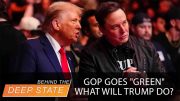Considering that President Donald Trump has been quite vocal in his intentions to withdraw the United States from the Paris Climate agreement (which had been accepted as binding on the United States by then-President Barack Obama), speculation has it that he will now do so. According to the terms of the 2016 agreement — reached November 4 of that year — a nation could not pull out during the first three years.
Those three years are now up, and under the terms of the agreement, Trump can pull the United States out following a one year’s notice. Trump can start the process of withdrawal with a letter to the United Nations. Were Trump to invoke that part of the deal and withdraw today, the United States would exit the deal the day after the 2020 presidential election.
Not surprisingly, officials associated with the Obama administration are expressing opposition to any move by Trump to pull out of the deal.
For example, Andrew Light, a State Department climate negotiator, has said that were Trump to lose the 2020 election, the new president could simply get back in the deal in only 30 days. Light is now with the World Resources Institute.
Opposition to Trump leaving the Paris climate agreement also comes from academia. Jake Jacoby, an economist with the Massachusetts Institute of Technology who was a co-founder of the MIT Joint Program on the Science and Policy of Global Change, predicted that were the United States to leave the deal, it would discredit U.S. leadership, and lead to “shame.”
Another academic, Gregg Marland of Appalachian State University, said, “We’re the second biggest player. What happens to the game if we take our ball and go home?”
When asked what the U.S. government intends to do on the Paris deal, James Dewey, a spokesman with the State Department, said in an e-mail on Friday, “The U.S. position with respect to the Paris Agreement has not changed. The United States intends to withdraw from the Paris Agreement.”
What exactly is involved in the Paris agreement? It calls for those nations signing the agreement to develop increasingly ambitious anti-CO2 actions every five years, beginning in November 2020. Advocates of the deal argue that climate change is caused by the burning of fossil fuels such as coal, oil, and gas, and that it has already caused weather extremes, melted ice across the world, and is expected to get worse. Among the problems these climate alarmists predict are a jump in world temperatures by several degrees, leading to a rise in sea levels of up to three feet.
Of course, all of these dire predictions are assertions that lack scientific proof.
But beyond the issue of alleged industrially-caused global climate change, the Paris deal raises certain constitutional questions that are simply not being asked by the mainstream media, most members of Congress, law-school professors, or even the Trump administration itself.
After all, presidents — including both Obama and Trump — took oaths to uphold the Constitution of the United States. So did every member of Congress. The Constitution is quite explicit in giving the president of the United States the authority to make treaties with other nations, but it is just as explicit in requiring that any such treaty agreed to by the president be ratified by a two-thirds vote of the U.S. Senate before it is considered law in the United States.
Nothing of the sort was done with the Paris agreement. President Barack Obama simply agreed to its terms. Without the ratification by two-thirds of the Senate, then, it is not legally binding upon the United States. In other words, President Trump could withdraw from the agreement today, without any letter or even a tweet to the United Nations.
In fact, Trump could have withdrawn from the deal the day he took office in January 2017, because, since Obama had not gotten any ratification from the Senate on the deal, it was not a law in the United States, and neither he nor the U.S. government was bound by it.
With all the talk of impeachment over matters that are trivial in comparison, why is there so little concern about a president — Obama — entering into an agreement, on his own, without following the Constitution? For that matter, why has Trump either not already pulled out, or submitted the agreement to the Senate for ratification?
Has Congress, which has essentially surrendered its power to declare war to the president, now surrendered its role in the making of foreign policy to the president as well? Each member of Congress took an oath to the Constitution, which requires that the Senate agree to any presidential agreement with other nations if it is to be considered law.
Whether one agrees with the Iran Nuclear Deal, it also should have been submitted to the Senate for ratification.
Members of Congress have meekly given up their constitutional powers to the executive branch, an action that they had no legal right to take.
And the trade deals that the United States has entered into over the years clearly are what the framers of the Constitution would have considered treaties. If President Trump takes his oath to the Constitution seriously, then his USMCA should not be subject to a simple majority vote of each house of Congress, but should be sent to the Senate, where it would require a two-thirds vote to have any legal standing at all.
The Mexican government considers the USMCA a treaty. Why shouldn’t the United States?
This issue — following the Constitution’s checks and balances on treaties — is far more important than a stained blue dress, a third-rate burglary in the Watergate building, or the firing of a secretary of war. It is certainly of far greater importance than what Trump said in a phone call to the president of Ukraine. Yet, the mainstream media and members of Congress say little to nothing about whether a U.S. president can make law through a simple executive agreement.
Photo: AP Images
Steve Byas is a university history and government instructor and author of several books, including History’s Greatest Libels. He can be contacted at [email protected]




